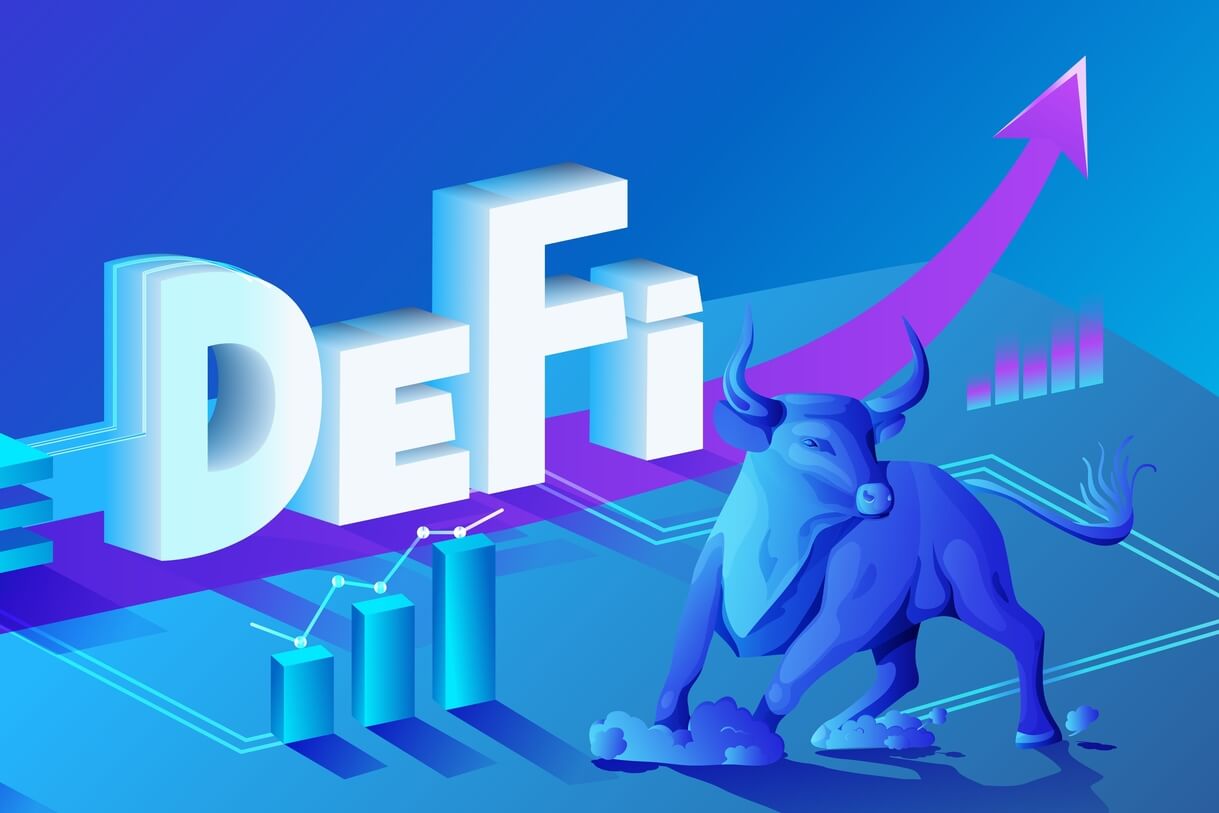DeFi Trends in 2022: Growing Interest, Regulation & New Roles for DAOs, DEXes, NFTs, and Gaming

____
_____
- People started looking at alternative options to going into a bank branch to get loans.
- A tectonic shift is expected in how we reshape the DeFi industry to better meet the expectations of investors and regulators.
- DAOs might be even more involved in DeFi next year.
- We might see some new NFT-related trading pairs and yield-bearing products in 2022.
- A “smooth integration” of DeFi and blockchain-based games is estimated also.
- We may witness increasing interoperability between DEXes next year.
The decentralized finance (DeFi) sector has grown spectacularly in 2021, feeding into the growth of the wider crypto market which in turn has fed into it. It now accounts for more than USD 200bn in total value locked in, having stood at around USD 22bn on January 1.
Speaking with Cryptonews.com, figures within the sector expect it to continue expanding in 2022. They also expect various sub-sectors within DeFi to witness considerable growth next year, from liquidity mining and yield farming to decentralized autonomous organizations (DAOs), decentralized exchanges (DEXes), and non-fungible tokens (NFTs).
However, commenters suspect we’ll finally see the introduction of legislation that directly bears on DeFi in 2022, although most also affirm that this will be a net positive for the sector, opening it up to mainstream interest and investment.
Continued growth, new types of user
As of writing, the crypto market is currently suffering a downturn. So an inevitable question emerges: can DeFi really sustain this year’s growth into next year?
“2021 saw a mix of COVID-19 still affecting our daily lives and ability to earn a living and the opening of the global trade/financial market after a very abnormal 2020. As a result, most people started looking at alternative options to going into a bank branch to get loans and at alternative assets to invest in, in order to diversify from traditional stocks/bonds types of investments,” said Brad Yasar, the CEO of EQIFI, a decentralized protocol for pooled lending, borrowing and investing.
As Yasar explains, this macroeconomic situation opened much of the public up to cryptoassets and decentralized finance products that diversify from traditional brick and mortar solutions. The result was a significant increase in DeFi and the crypto market’s capitalization, and this is a trend Yasar expects to continue in 2022, led by increasing involvement from traditional financial institutions.
“As more traditional banking and financial services institutions realize that they can grow faster and serve more clients more efficiently by adopting some DeFi principles, we expect to see wider adoption and continued growth in DeFi,” he told Cryptonews.com.
Likewise, Swarm Markets co-founder Timo Lehes expects that new types of assets, regulatory clarity, institutional seals of approval, and lower transaction costs will increase mainstream adoption of DeFi next year.
“Bringing more real-world assets and financial products, like securities, on-chain will expand the DeFi ecosystem dramatically, attracting more investors and traders alike. DeFi offers more opportunities than traditional markets to earn yield from a broader set of asset types and gives people greater autonomy to build wealth,” he said.
Other industry figures expect DeFi to open itself up to more than preexisting crypto-natives in 2022. One of these is AllianceBlock CEO and Co-Founder Rachid Ajaja, who affirms that his own personal experience indicates that traditional players and institutional entities are increasingly interested in gaining access to DeFi.
“A survey from CoreData recently showed that 7 in 10 wealth advisors had spoken to clients about cryptoassets, while a Goldman Sachs survey showed that roughly 15% of family offices worldwide have some exposure to crypto, something that would not have been the case a few years ago,” he told Cryptonews.com.
DeFi regulation will become a reality in 2022
Ajaja also notes that one of the biggest roadblocks for institutions right now is compliance and regulation. Fortunately, 2022 will witness progress on this front from multiple angles, with the DeFi regulations, predicted for 2021, finally becoming a reality next year.
“Across DeFi, [know-your-customer, KYC] and [anti-money laundering, AML] solutions and wallets with inbuilt KYC and cross border rules checks will help to increase institutional exposure in the year ahead. AllianceBlock’s Cross-Border Regulatory Compliance Rules Engine allows traditional institutions to access opportunities in DeFi in a compliant way through pre-trade international checks,” he said.
Timo Lehes also agrees that regulation will be key in 2022, since those with a fiduciary responsibility simply cannot access DeFi via unregulated platforms and services.
“The good news is that some top-tier jurisdictions, like Germany, have already brought cryptoassets in line with existing securities laws. Entrepreneurs seeking to build DeFi projects that attract this sidelined capital could find opportunities there,” he said.
More specifically, Lehes estimates that regulators will increasingly act next year, following 2021 in which they increasingly came to debate and discuss the regulatory implications of DeFi. He also suggests that some may benefit from following the example set by Germany’s regulator BaFin, which issued clear guidance on cryptoasset regulation in an amendment to the German Banking Act in 2020.
“As the conversation around crypto regulation transitions into action in 2022, we expect to see a tectonic shift in how we reshape the DeFi industry to better meet the expectations of investors and regulators,” he said.
Rachid Ajaja expects that the EU’s upcoming Regulation of Markets in Cryptoassets (MiCA) will have strong implications for the DeFi sector. He also points towards increased scrutiny from the US Securities and Exchange Commission and US government, which will require protocols and platforms to significantly improve their compliance game.
“In order for the DeFi sector to meet these requirements and truly feel the benefits of clearer guidelines, effective cross-border regulatory compliance and KYC/AML frameworks are needed. Traditional and decentralized exchanges are crying out for these solutions, which will help to provide a compliant gateway to valuable digital assets,” he said.
For DappRadar’s CDO Dragos Dunica, the regulatory challenges facing DeFi in 2022 might be substantial, but the sector is well-positioned to rise to them.
“I think the DeFi sector will do everything it can to legitimize itself and become a true competitor to CeFi [centralized finance],” he told Cryptonews.com.
In fact, Dunica says that the growth of DeFi in 2022 will be such that governments may start rolling out their own platforms and initiatives, once the regulatory landscape has been settled. “Things such as universal basic income (UBI) have been on the table for years and blockchain and crypto could be able to solve the problems of distribution and fairness,” he added.
NFTs, DAOs, GameFi, Liquidity Mining, DEX Interoperability
Assuming that the DeFi sector will be able to clear increasing regulatory hurdles in 2022, it will be able to benefit from offering a growing range of products to investors. Top of this list will be products involving non-fungible tokens.
“In 2022, NFTs will evolve to represent assets with intrinsic value and thanks to the composability of DeFi, we will see some interesting trading pairs and yield-bearing products, as a result,” said Timo Lehes.
Lehes adds that he expects to see NFTs for securities like company stock or even the US Constitution in 2022.
As a matter of fact, the US Constitution hit headlines in 2021 when a DAO raised more than USD 40 million-worth in crypto in order to purchase one of its few surviving copies. And Lehes also expects to see DAOs being increasingly involved in DeFi next year.
“We expect to see DAOs, investor protections and [a widening] scope of financial activities alongside DeFi and NFTs, being a key theme for crypto in 2022. Increasing the scope of what can be executed via smart contracts, will dramatically expand what is possible in crypto and DeFi next year and beyond,” he added.
The growing involvement in DAOs is also something predicted as a 2022 trend by Solo Ceesay, the Chief Operating Officer and Co-Founder at social marketplace Calaxy.
“DAOs are not only a useful means of equitable decision-making, they can also serve as an effective mechanism to offload risk amongst a pool of community members. Similar to single-tranche structured credit vehicles, the pooling of this type of risk will create opportunities for investors to passively gain exposure to a particular type of risk,” he told Cryptonews.com.
One of crypto’s biggest success stories of the year has been Axie Infinity, which went from 38,000 daily active users in April to 2.7 million in mid-November. This growth in blockchain-based games is likely to provoke a parallel growth in GameFi, with DeFi obviously being a big part of this.
“As we’ve already seen through the lens of [decentralized applications, dapps] like Axie Infinity and Alien Worlds, we expect to see the further rise of gamified finance dapps and play-to-earn mechanics. The gamification of DeFi has led the industry to all-time high user figures, surpassing over 2 million active wallets in October,” said Dragos Dunica.
He expects a “smooth integration” of DeFi and blockchain-based games to occur in 2022, creating a space that will expand by virtue of its promise of giving “users a fun and rewarding experience.”
Another two areas likely to grow in importance next year are liquidity mining and yield farming. This, at least, is the prediction of Rachid Ajaja, who says that providing liquidity is hugely important for the healthy running of DEXes, although it’s currently held back by the threat of impermanent loss (where providers risk losing some of their initial investment due to price changes).
“Reducing impermanent loss is imperative to the development of liquidity mining. New formulas for automatic market makers that reduce impermanent loss are being developed, and the results look promising,” he explained.
Ajaja also estimates that 2022 will witness increasing interoperability between DEXes, which is vital for improving liquidity, among others.
“Facilitating interoperability and the ability to trade between DEXes on different chains is pivotal to the next phase of DeFi. Further innovations aiming to mitigate risk for users and improve [user experience] and [user interface] will make processes on DEXes more seamless,” he added.
While the above predictions cover a broad sweep of what’s likely to happen to DeFi in 2022, it’s still worth noting that the sector remains in its infancy and is growing at a rapid pace. As such, what’s most exciting about next year is not so much what’s predicted to happen, but what hasn’t been predicted.
_____
Learn more:
– Crypto Security in 2022: Prepare for More DeFi Hacks, Exchange Outages, and Noob Mistakes
– Crypto Industry Insiders Share Top Ethereum, DeFi, Gaming, and TradFi Trends for 2022
– How Global Economy Might Affect Bitcoin, Ethereum, and Crypto in 2022
– Crypto Exchanges in 2022: More Services, More Compliance, and Competition
– 2022 Crypto Regulation Trends: Focus on DeFi, Stablecoins, NFTs, and More
– Crypto Investment Trends in 2022: Brace for More Institutions and Meme Manias
– Crypto Adoption in 2022: What to Expect?
– Bitcoin and Ethereum Price Predictions for 2022




